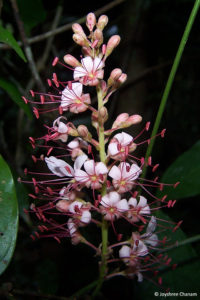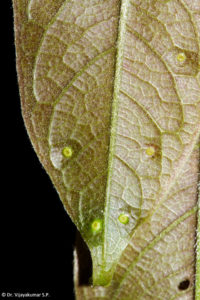Who said only humans are selfish in a friendship?
There is a plant named Haasige Mara which when translated to Kannada literally means ‘bed-tree ‘and it has been named aptly so. Present across Southern India, Humboldtia brunonis or Haasige Mara is a plant that creates a mutualistic relationship by providing treats and shelter to ants in the jungle, which in turn protects it from predators. Much like Shahrukh Khan in Raees, who gives jobs and lends money to people, who in turn ensure that the cops don’t catch a whiff of his bootlegging business.

Haasige Mara
Dr Joyshree Chanam is working on her post-doctoral degree from NCBS (The National Centre for Biological Services), Bangalore, but prior to this, she spent six months following the sweet smell of Haasige Mara and its friendship story with the ants on the hills of Agumbe. She was at 1Shanthiroad recently for the series of talks under the bi-monthly ‘Café Oikos’ (Read more about the series: https://opendosa.in/why-drongo-is-the-new-khal-drogo/)which brings together various researchers on ecology and conservation, and their discoveries to the ‘non-science’ population.
Haasige Mara is usually as tall as an average pomegranate or guava tree and bears flowers with white petals and pink sepals.
Plants have a wide range of defence mechanisms that they adopt when necessary. These are categorised into direct and indirect defences. In her research, Dr Chanam was able to find that Haasige Mara requires friendship with ants due to higher herbivory pressure in the Western Ghats. Herbivory pressure is a phenomenon observed in an ecosystem when a plant species seek help from other species to protect itself from predatory herbivores.
This is a part of natural selection. Herbivory pressure increases when there is higher tissue damage in the plant, restricting its growth and reproduction. In this case, the humble Humboldtus gets help from ants in return for the food and shelter it provides them.
The food, called extrafloral nectar, is present in the form of small droplets on the leaf of the plant and has a sweet taste. “The young leaves have nectar on their sepals,” Dr Chanam says. Ants, as we all know, are suckers for sugar and come in droves to consume them.

Active extrafloral nectar spots on a leaf
It’s an Ant Plant
“It is an ant-plant” she says. In ecological terms, it is a myrmecophyte(myrmeco = ants, phyta = plants). Things get more interesting when some of these species form long rooms for the ants to live in. These ant-shelters are called domatia. However, not all of them stay in the domatia.
She found that out of the 16 species of ants that come for the food, only one of them – Technomyrmexalbipes – occupies the domatia and becomes a bodyguard to the plant. “These ants are really aggressive and drive away caterpillars and even elephants.”
An arboreal (living in trees) earthworm which goes by the name of Perionyxpullus has also been observed to be a resident in the domatia of H. brunonis. These earthworms have slimy and acidic mucus on their bodies which the ants find repelling. To coexist, they build a wall between themselves and the earthworm.
Dr Chanam raises an important question here – “Is there a geographical variation in rewards? Does it affect the quantity and quality of extrafloral nectar?” Upon research, she found that the answer yes. Due to high herbivory pressure in the Ghats, the quantity of nectar is more per volume, attracting more numbers of ants.
The ants, apart from protecting the plant also provide it with nutrients. Dr Chanam found some species of fungal hyphae that absorb the excreta produced by the ants as well as nutrients for the plant both inside and outside the domatia.
An interesting question from an attendee was whether these ants affect pollination in any way. “Ants are notorious, they frighten away pollinators,” Dr Chanam said. Crematogasterdohrni is a species of notorious ants that cut the anther of the plant, which contains the pollen grains. As a result of no pollination, the plant continues to produce nectar.
Who said only humans are selfish in a friendship? Another interesting question was how ants recruit their friends to come to a particular leaf. The forager ant upon finding a food source takes some of it back to the nest for his friends. Through trophallaxis (the exchange of liquids from one antenna to another), other ants get a taste of it, and then the entire ant army approaches the food source in all their glory.
“Fieldwork is highly enriching not only because of nature but also due to the people you meet as well,” says Dr Chanam. She displayed pictures of people she has lived with during her time in the jungles of Western Ghats, living only with bare necessities. It makes one think about the fact that it is not only nature that can be wondrous, but also living with nature.
Picture credits: http://jlrexplore.com/explore/focus/humboldtia-brunonis-the-perfect-host
Pictures by Joyshree Chanam, Karthikeyan S. and Dr.Vijayakumar S.P.
Latest posts by Udipto Phukan (see all)
- The Dignity March - 12th January 2019
- Cheeti Cheeti Bang Bang - 12th July 2018
- Why Drongo is the New Khal Drogo - 30th April 2018





